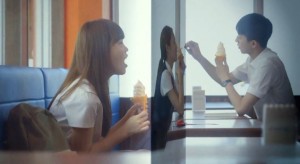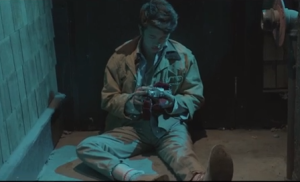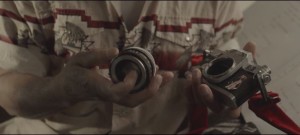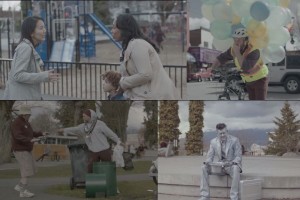Akdong Muscian’s much-awaited debut has finally dawned upon fans of the duo, and the saturated K-pop world has become a much better place. Especially since YG set the bar high with Lee Hi’s debut, the sibling pair had big shoes to fill, and fill it they did.
They will be releasing a total of three MVs – “200%” chosen by Yang Hyun-suk, “Melted” chosen by the pair themselves, and “Give Love” chosen by the fans. With Akdong’s unique style and innocent image, let’s quickly take a look at the two MVs that have been released so far
“200%” is a bright and whimsical pop song, with the chorus line being particularly addictive. The message of the song and the MV is simple, if not straightforward to understand – Average girl likes hot boy. Hot boy likes hot girl, heartbreak for average girl, the end.
[youtube http://www.youtube.com/watch?v=0Oi8jDMvd_w]That said, what clinched the prize for this possibly clichéd storyline laid entirely in the MV’s simplicity and execution. Nursing her unrequited love, Soo-hyun plays the role of a stalker-like teenager, who is obsessed with spying on her cute boy crush, even if she’s not the most adept spy around. While Soo-hyun is trying to go unnoticed, she is also trying to seek his attention in little ways, seen by the small steps that she takes towards him at the bus stop. It’s a youthful dilemma that everyone has faced before, battling the desire and embarrassment of your crush spotting you, and Soo-hyun conveys the struggle convincingly.
 All of a sudden, the audience is tricked into thinking that the boy reciprocates her feelings, as we see multiples scenes of them going on dates to an ice-cream parlour, to a beach and so on. Just as we think that this MV will deliver a happily-ever-after ending, the audience realizes that this scenes have only been playing out in Soo-hyun’s imagination, and the reality of the situation is far from the truth. We literally see the scene unfold to reveal the real girlfriend, and this idea struck me as exceptionally creative since it made the MV that much more out-of-the-box. The paper crane with the broken wing is an accurate representation of the devastation of Soo-hyun’s infatuation.
All of a sudden, the audience is tricked into thinking that the boy reciprocates her feelings, as we see multiples scenes of them going on dates to an ice-cream parlour, to a beach and so on. Just as we think that this MV will deliver a happily-ever-after ending, the audience realizes that this scenes have only been playing out in Soo-hyun’s imagination, and the reality of the situation is far from the truth. We literally see the scene unfold to reveal the real girlfriend, and this idea struck me as exceptionally creative since it made the MV that much more out-of-the-box. The paper crane with the broken wing is an accurate representation of the devastation of Soo-hyun’s infatuation.
Soo-hyun did a particularly winning job as the love-obsessed girl, it felt completely natural, that even the director was surprised at her ease at acting as a stalker. Chan-hyuk had significantly less screentime, but he made his scenes count by utilizing his adorkable actions to convey the (secondhand) embarrassment that love can cause. Something else that I enjoyed about the MV, was the series of pictures shown in quick succession to match whatever was mentioned in the lyrics. It didn’t contribute much to the story, but it did add some entertainment value. All in all, a fun song with an enchanting MV.
“Melted” is a much more solemn and mellow song, and it surprised me, in a good way, that a pair of teenagers chose it to be one of their title songs. The song observes how cold humanity has become, likening it to the freezing of ice. And it pushes for people to thaw, to bring about warmth and happiness that’s buried deep within.
[youtube http://www.youtube.com/watch?v=sUCIzn0mRHc]If you watch the MV without the music, you would be hard pressed to guess it was a K-pop MV. The characters, the message, the execution, are on a whole different level from any of the MVs I’ve ever watched. In fact, its contemplative portrayal of poignancy and pathos, as well as the artistic camera direction, could even have passed it off as a short film.
Firstly, the cast is mainly non-Asian, however, it boasts none of that “foreign is exotic” message that many K-pop MVs tend to undertake. The multitude of races featured in the MV suggests that this issue is an issue of humanity, and not one particularly targeted towards any single country or race.
 In the MV, the song is presented as a flashback of the businessman, looking back to the days where he was a teenager with a camera always in hand. In the start, we see the businessman holding a glass of iced drink, representing all the times that he’s been hit in the face with cold and hardened adults.
In the MV, the song is presented as a flashback of the businessman, looking back to the days where he was a teenager with a camera always in hand. In the start, we see the businessman holding a glass of iced drink, representing all the times that he’s been hit in the face with cold and hardened adults.
Encounter 1: The aloof person. Initially doing a good deed by giving the boy a ride, the middle-aged man then proceeds to ditch him at the side of the road, when the boy started poking around the belongings in the car and snapping pictures of it. Accustomed to their own personal space, people do not respond well to attempts by others to build a bond; it suggests that the desire for solitude causes people to behave icily and distant from each other.
Encounter 2: The judgemental person. The shop-owner gives the boy a scathing a look for paying in small change, possibly assuming that he’s a runaway boy, but makes no effort to reach out to him.
Encounter 3: The lethargic or unsympathetic person. As the boy wonders around the streets, he is constantly capturing stills of people from all walks of life, in various states of disagreement, hostility, stress, and tiredness.
 Encounter 4: The selfish person. With hope not all gone, the boy thinks the smiling lady could possibly prove different from his previous experience, especially since she opens up about her personal life by showing him her photo album. Unfortunately, it amounts to the same thing when the lady eventually leaves him behind to go off with her arm candy, and the barman even injures the boy for not being able to pay up. This lack of love and tenderness in humanity is apparent in the “every man for himself” motto that many people live by.
Encounter 4: The selfish person. With hope not all gone, the boy thinks the smiling lady could possibly prove different from his previous experience, especially since she opens up about her personal life by showing him her photo album. Unfortunately, it amounts to the same thing when the lady eventually leaves him behind to go off with her arm candy, and the barman even injures the boy for not being able to pay up. This lack of love and tenderness in humanity is apparent in the “every man for himself” motto that many people live by.
Encounter 5: The dismissive person. Left to his last hope, the boy hopes to find an ally in the police, since they epitomize authority of moral character. However, they too disappoint him when the policewoman gives him the “talk to the hand” gesture, and that spells the last straw for the boy.
At this stage, we see that the ice in the drink has not yet melted, possibly even turning ice-cold — a parallel of how the boy has been jaded by his previous encounters of iciness. When he tries to be friendly to the dog, which he hoped would be more benevolent, the growling of the dog triggers him to finally retaliate aggressively in desperation. Fortunately, the Native American man flouts his expectations, and extends kindness and hospitality to him. As time flashes back to the present, we see that the boy has now grown up to be successful. The ice in his cup finally melts into water, representing how the warmth of that one man has impacted him in his life.
 The use of symbolism is scattered throughout the MV, and it’s up to the audience how deep they want to dissect it. The boy is told off for his insistence on taking photos; the camera is destroyed by the barman, and then repaired by the kind Native American. The camera, in this instance, could represents his ability to make memories. However, he’s constantly prevented by adults from making such memories of his childhood, whether by discouragement, or the physical destruction of the camera. However, the one act of kindness extended to him, the repair of the camera, revives his ability to make memories. The camera could also symbolize an adolescent’s dream, which was accidentally destroyed by the barmen, but fortunately eventually revived.
The use of symbolism is scattered throughout the MV, and it’s up to the audience how deep they want to dissect it. The boy is told off for his insistence on taking photos; the camera is destroyed by the barman, and then repaired by the kind Native American. The camera, in this instance, could represents his ability to make memories. However, he’s constantly prevented by adults from making such memories of his childhood, whether by discouragement, or the physical destruction of the camera. However, the one act of kindness extended to him, the repair of the camera, revives his ability to make memories. The camera could also symbolize an adolescent’s dream, which was accidentally destroyed by the barmen, but fortunately eventually revived.
The role of the boy and adults can be interpreted in two ways. They can be interpreted literally, with the boy representing the innocent and naive younger generation, and the adults representing the jaded older generation. A figurative interpretation could be that the boy represents the innate purity of the human race, which is quickly contaminated by malice and frostiness of people, represented by the adults. The choice to tell this story from the perspective of a teenager was extremely appropriate, especially since it was composed by 18-year old Chan-hyuk.
 And of course, the most important symbol of the MV – ice. At room temperature, ice melts into water, implying warmth is the default state of humans. Ice is formed because of the cold, which is not a thing per se, but merely an absence of heat. Similar to how darkness is the absence of light, if humans don’t actively strive to stay warm-hearted, we inevitably turn into ice blocks devoid of all warmth, as humanity loses their passion, their sympathy, their love, their concern. And we are reminded that loss of heat is a ripple effect, as one block of ice can reduce the warmth of the surroundings. Similarly, all it takes is only one person, to undo the process and trigger a wave of heat to the other ice blocks.
And of course, the most important symbol of the MV – ice. At room temperature, ice melts into water, implying warmth is the default state of humans. Ice is formed because of the cold, which is not a thing per se, but merely an absence of heat. Similar to how darkness is the absence of light, if humans don’t actively strive to stay warm-hearted, we inevitably turn into ice blocks devoid of all warmth, as humanity loses their passion, their sympathy, their love, their concern. And we are reminded that loss of heat is a ripple effect, as one block of ice can reduce the warmth of the surroundings. Similarly, all it takes is only one person, to undo the process and trigger a wave of heat to the other ice blocks.
There are many more symbols sprinkled around — the boxes in the man’s car symbolizing a person’s emotional baggage, the lady’s make-up depicting a mask people put on to hide their true feelings, the collection of items in the trailer — the hot drink, pot of pasta, smoking sparkler — reiterating the compassion and tenderness that a person can encompass.
 YG has greatly taken me by surprise, since the style of Akdong is worlds apart from that of YG. Yang Hyun-suk made the right decision in handing over the reins of producing and composing to Chan-hyuk, who already boasts phenomenal and mature song-writing abilities at his young age.
YG has greatly taken me by surprise, since the style of Akdong is worlds apart from that of YG. Yang Hyun-suk made the right decision in handing over the reins of producing and composing to Chan-hyuk, who already boasts phenomenal and mature song-writing abilities at his young age.
On its own, the song already boasts a heavy message with its haunting melody. Paired together with the MV, this song becomes somewhat of a social commentary; it’s does not seek to entertain as much as it aims to convey a message. It’s not something you watch, and then immediately forget about. It’s something that would stick with you, and prod you to reflect on the state of the world. And that, is how music changes the world.
Ratings:
“200%” MV: 4/5
“Melted” MV: 5/5
It’s amazing how these two MVs are opposite ends of the spectrum, and Akdong has definitely proved their versatility with their debut. Which was your favourite MV, and do you have any different interpretations of them?


